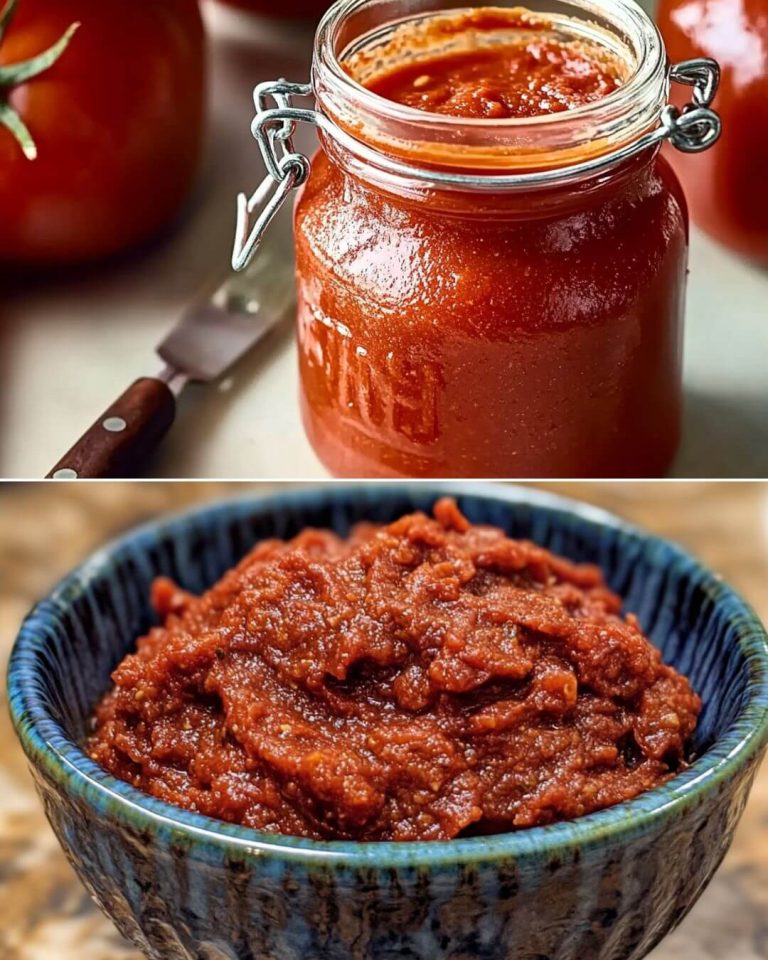Creating homemade tomato paste represents an excellent method for preserving the summer harvest while maintaining control over ingredients and quality. This straightforward recipe transforms fresh tomatoes into a concentrated, flavorful paste suitable for professional and home kitchens alike. The process, while time-intensive, requires minimal active preparation and yields a superior product compared to commercial alternatives.
Essential Information
This recipe produces a concentrated tomato paste that serves as a foundational ingredient in numerous culinary applications. The preparation method ensures proper preservation through either water bath canning or freezing, making it suitable for long-term storage.
Ingredients
Primary Components
- Fresh tomatoes: 10 pounds (4.5 kg), preferably paste varieties
- Extra virgin olive oil: 2 tablespoons (30 ml)
- Sea salt: 2 teaspoons (10 g)
Preservation Acidifier (Select One)
- Citric acid: 1/2 teaspoon (2.5 g)
- Bottled lemon juice: 2 tablespoons (30 ml)
Professional Equipment Requirements
Essential Equipment
- Food mill, sieve, or chinois
- 2 large rimmed baking sheets
- Large cooking pot
- 4-ounce canning jars with lids and bands
Optional Equipment
- Water bath canner (if preserving via canning method)
- Jar funnel
- Canning tools
Detailed Production Process
Phase 1: Preparation
- Position oven racks to divide the cavity into thirds
- Preheat oven to 350°F (175°C)
- Quarter all tomatoes
- Prepare sterilized preservation jars if utilizing the canning method
Phase 2: Initial Processing
- Heat olive oil in a large pot over medium-high heat until shimmering
- Add quartered tomatoes
- Simmer until tomatoes soften and skins begin separating from flesh
- Process softened tomatoes through food mill to remove seeds and skins
- Incorporate sea salt and selected acidifier into the processed pulp
- Distribute pulp evenly between two baking sheets
Phase 3: Reduction Process
- Place prepared baking sheets in preheated oven
- Rotate sheets and stir paste at 30-minute intervals
- Combine contents onto single sheet when volume reduces significantly
- Continue baking until paste achieves desired consistency
- Target consistency: thick, brick-colored, glossy appearance
- Expected duration: 3-4 hours
- Visual indicator: no liquid separation
Phase 4: Preservation
Method A: Water Bath Canning
- Transfer paste to prepared 4-ounce jars, leaving 3/4-inch headspace
- Apply lids and bands to manufacturer specifications
- Process in boiling water bath for 15 minutes
- Cool completely before storing
- Storage duration: up to 1 year in cool, dark location
Method B: Refrigeration/Freezing
- Transfer paste to storage containers
- Apply protective olive oil layer
- Seal containers appropriately
- Refrigerate for 3-4 weeks or freeze for up to 9 months
Nutritional Information
Per tablespoon (15g):
- Calories: 15
- Protein: 0.8g
- Carbohydrates: 3.3g
- Dietary Fiber: 0.9g
- Sugars: 2.1g
- Sodium: 55mg
- Potassium: 162mg
- Vitamin C: 3.5mg
Production Timeline
- Preparation: 30 minutes
- Initial cooking: 20 minutes
- Reduction: 3-4 hours
- Processing time: 30 minutes
- Total duration: 4-5 hours
Professional Guidelines and Recommendations
Quality Selection Parameters
The selection of tomatoes significantly impacts the final product quality. Roma or San Marzano varieties offer optimal results due to their:
- Higher solid content
- Lower moisture percentage
- Superior flesh-to-seed ratio
- Consistent flavor profile
Critical Control Points
- Temperature Management
- Maintain consistent oven temperature throughout reduction
- Monitor product temperature during canning process
- Ensure proper cooling before storage
- pH Considerations
- Verify proper acidification for safe preservation
- Maintain consistent acid distribution throughout product
- Document pH levels for quality control
- Moisture Content
- Continue reduction until achieving proper consistency
- Ensure complete elimination of water separation
- Maintain appropriate headspace in storage containers
Variations and Adaptations
Seasoning Options
Consider incorporating these complementary ingredients:
- Roasted garlic
- Fresh herbs
- Black pepper
- Red pepper flakes
Production Scale Modifications
For commercial quantities:
- Utilize industrial food mills
- Implement convection ovens
- Scale ingredients proportionally
- Adjust processing times accordingly
Common Technical Issues and Solutions
Issue 1: Excessive Moisture
Solution: Extend reduction time and ensure proper heat distribution
Issue 2: Color Variation
Solution: Maintain consistent temperature and stirring intervals
Issue 3: Preservation Failures
Solution: Verify proper acidification and processing procedures
Issue 4: Texture Inconsistencies
Solution: Adjust initial processing and straining methods
Storage and Stability Guidelines
Environmental Parameters
- Maintain consistent storage temperature
- Protect from direct light exposure
- Monitor humidity levels
- Ensure container integrity
Quality Assurance
- Regular inspection of stored product
- Documentation of production dates
- Rotation of inventory
- Monitoring of preservation seals
This tomato paste production method yields a premium product suitable for various culinary applications while maintaining optimal safety and quality standards. The detailed process ensures consistency and reliability in the final product, making it appropriate for both professional and domestic environments.
